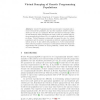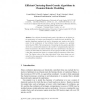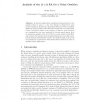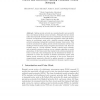GECCO
2004
Springer
15 years 6 months ago
2004
Springer
Abstract. Genetic Programming often uses excessive computational resources because the population size and the maximum number of generations per run are not optimized. We have deve...
GECCO
2004
Springer
15 years 6 months ago
2004
Springer
For problems where the evaluation of an individual is the dominant factor in the total computation time of the evolutionary process, minimizing the number of evaluations becomes cr...
104
Voted
GECCO
2004
Springer
15 years 6 months ago
2004
Springer
A reduced model technique based on a reduced number of numerical simulations at a subset of operating conditions for a perfectly stirred reactor is developed in order to increase t...
105
click to vote
GECCO
2004
Springer
15 years 6 months ago
2004
Springer
Two efficient clustering-based genetic algorithms are developed for the optimisation of reaction rate parameters in chemical kinetic modelling. The genetic algorithms employed are ...
118
click to vote
GECCO
2004
Springer
15 years 6 months ago
2004
Springer
Abstract. In practical applications evaluating a fitness function is frequently subject to noise, i. e., the “true fitness” is disturbed by some random variations. Evolutiona...
111
click to vote
GECCO
2004
Springer
15 years 6 months ago
2004
Springer
Spiking neural networks are computationally more powerful than conventional artificial neural networks. Although this fact should make them especially desirable for use in evoluti...
83
Voted
GECCO
2004
Springer
15 years 6 months ago
2004
Springer
In this paper, we present simple and genetic forms of an evolutionary paradigm known as a society of hill-climbers (SoHC). We compare these simple and genetic SoHCs on a test suite...
108
click to vote
GECCO
2004
Springer
15 years 6 months ago
2004
Springer
Artificial Immune Systems (AISs) are biologically inspired problem solvers that have been used successfully as intrusion detection systems (IDSs). This paper describes how the des...
106
click to vote
GECCO
2004
Springer
15 years 6 months ago
2004
Springer
In this work genetic programming is used to express and evolve trading strategies for a foreign exchange currency market simulator.
118
Voted
GECCO
2004
Springer
15 years 6 months ago
2004
Springer
Abstract. Designing storage area networks is an NP-hard problem. Previous work has focused on traditional algorithmic techniques to automatically determine fabric requirements, net...




